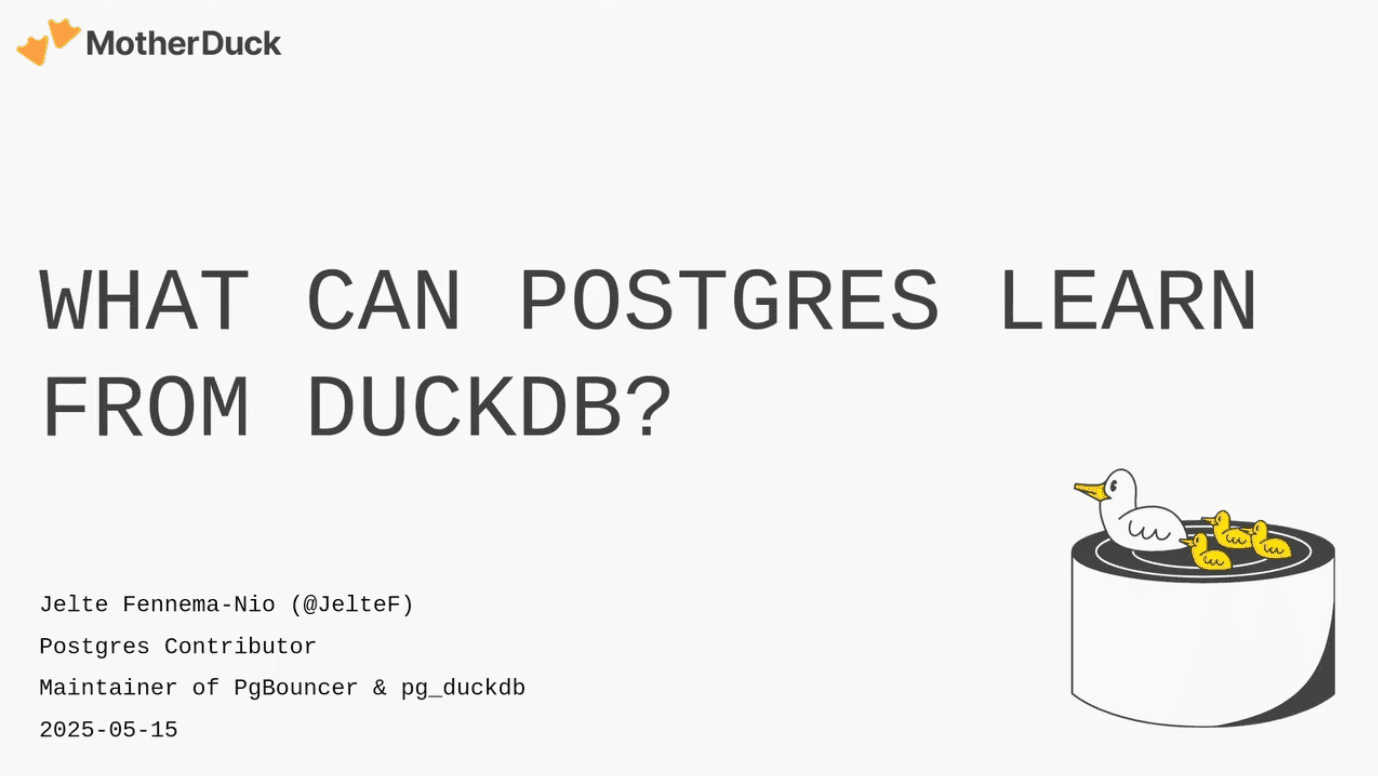How to Efficiently Load Data into DuckLake with Estuary
2025/07/26Introduction to DuckLake and Real-Time Data Integration
DuckLake represents a new open table format created by the developers of DuckDB. Unlike traditional data lake formats that store metadata in JSON or Avro files within blob storage, DuckLake takes a different approach by storing metadata in a relational database. This architectural decision significantly speeds up metadata transactions, making operations faster and more efficient.
Understanding MotherDuck's Cloud Data Warehouse
MotherDuck is a cloud data warehouse designed to make big data feel small. Built on top of DuckDB, it focuses on three key principles:
- Eliminating complexity from traditional distributed data warehouses
- Enabling fast insights while keeping developers in their workflow
- Leveraging DuckDB's performance for cost-efficient operations
The platform integrates seamlessly with existing data stack tools and supports standard SQL queries with enhanced features.
Estuary's Real-Time Data Integration Platform
Estuary provides a real-time data integration platform that supports both streaming and batch data movement. The platform features:
Architecture Components
- Capture connectors that extract data from source systems using change data capture (CDC)
- Collections stored in object storage (S3, GCS, or compatible systems)
- Materialization connectors that load data into destinations
Key Capabilities
- Support for hundreds of source and destination systems
- Native CDC for databases like PostgreSQL, MySQL, and Oracle
- Real-time extraction from SaaS applications like Salesforce and HubSpot
- No-code setup with managed service
Setting Up a Real-Time Pipeline to DuckLake
The process of loading data into DuckLake involves several straightforward steps:
Source Configuration
- Connect to your source database (PostgreSQL, MySQL, etc.)
- Enable change data capture to track real-time changes
- Configure schema evolution settings for automatic handling of schema changes
DuckLake Setup
- Create a DuckLake database in MotherDuck
- Configure access to your S3 bucket where data will be stored
- Set up appropriate access tokens for read/write permissions
Pipeline Configuration
- Choose sync frequency (from real-time to scheduled batches)
- Select specific fields to materialize
- Configure merge queries for maintaining latest state
Performance Optimization with MotherDuck
Instant SQL Feature
MotherDuck introduces Instant SQL, which provides query results at the speed of typing by:
- Pre-caching data for immediate feedback
- Validating SQL syntax in real-time
- Enabling rapid iteration on complex queries
Storage Trade-offs
When deciding between DuckLake and MotherDuck native storage:
DuckLake advantages:
- Open format with broader ecosystem compatibility
- Support for Spark and other compute engines
- Better suited for petabyte-scale workloads
MotherDuck storage advantages:
- 2-10x faster query performance
- Optimized for read/write throughput
- Better caching and regional performance
Scaling Considerations
MotherDuck now offers larger instance sizes (Mega and Giga) to support intensive data lake operations. These instances are comparable to Snowflake 3XL configurations and enable:
- Terabyte to petabyte-scale operations
- Complex aggregations and sorting
- Efficient medallion architecture implementations
Best Practices for Implementation
Data Architecture
- Keep raw data in DuckLake for openness and flexibility
- Move silver/gold layer data to MotherDuck storage for performance
- Use Estuary's intermediate storage for reliability and replay capabilities
Partitioning Strategy
While Estuary doesn't natively configure partitions, you can:
- Allow Estuary to create initial tables
- Use
ALTER TABLEcommands to add partitions - Subsequent writes will respect partition configuration
Error Handling and Reliability
The architecture prevents common streaming issues:
- Intermediate storage prevents message loss
- Automatic handling of destination unavailability
- Support for backfills without re-querying sources
Integration with Modern Data Stack
The combination of Estuary and MotherDuck integrates with existing tools:
- dbt support through DuckDB adapter
- AI-powered SQL writing assistance
- Automatic error detection and fixing
- Support for multiple materialization targets from single source
This architecture enables organizations to implement real-time data pipelines without the traditional complexity of streaming systems, making the difference between batch and streaming simply a configuration toggle rather than an architectural decision.
TABLE OF CONTENTS
TABLE OF CONTENTS
Related Videos

2025-09-10
From Curiosity to Impact How DoSomething Democratized Data
Hear how DoSomething's data team escaped the enterprise data trap, achieving 20X cost reduction and transforming hours-long queries into seconds with MotherDuck.
YouTube

20:44
2025-06-13
What can Postgres learn from DuckDB? (PGConf.dev 2025)
DuckDB an open source SQL analytics engine that is quickly growing in popularity. This begs the question: What can Postgres learn from DuckDB?
YouTube
Ecosystem
Talk

2025-06-12
pg_duckdb: Ducking awesome analytics in Postgres
Supercharge your Postgres analytics! This talk shows how the pg_duckdb extension accelerates your slowest queries instantly, often with zero code changes. Learn practical tips and how to use remote columnar storage for even more speed.
Talk
Sources

